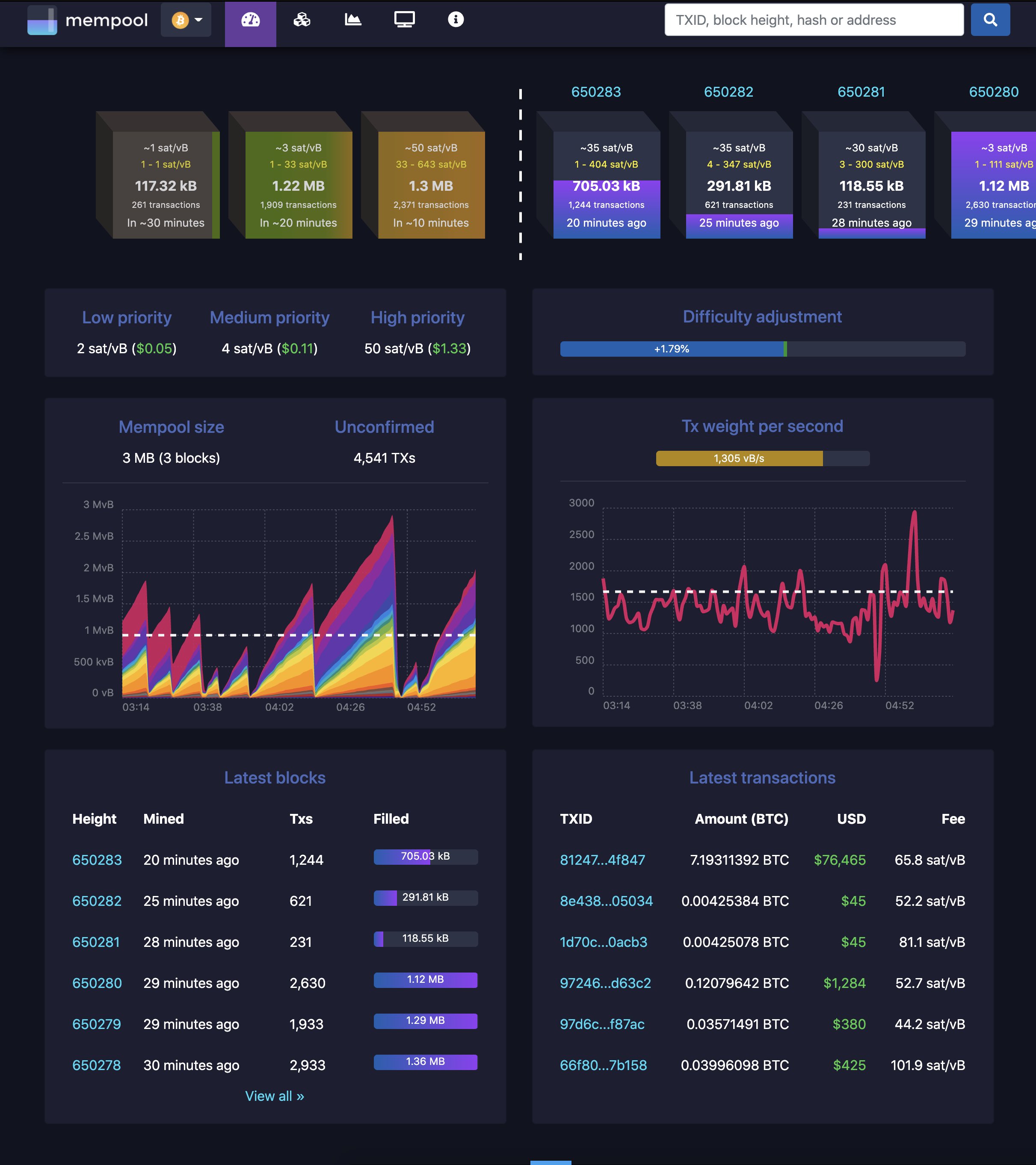The Mempool Open Source Project
Mempool is the fully featured mempool visualizer and block explorer website and API service running on mempool.space. The instructions below are for most users at home running on low-powered Raspberry Pi devices, but if you want to run a production website on a powerful server, see the production setup guide
Installation
Dependencies
- Bitcoin Core (no pruning, txindex=1)
- Electrum Server (romanz/electrs)
- NodeJS (official stable LTS)
- MariaDB (default config)
- Nginx (use supplied nginx.conf and nginx-mempool.conf)
Mempool
Clone the mempool repo, and checkout the latest release tag:
git clone https://github.com/mempool/mempool
cd mempool
latestrelease=$(curl -s https://api.github.com/repos/mempool/mempool/releases/latest|grep tag_name|head -1|cut -d '"' -f4)
git checkout $latestrelease
Bitcoin Core (bitcoind)
Enable RPC and txindex in bitcoin.conf:
rpcuser=mempool
rpcpassword=71b61986da5b03a5694d7c7d5165ece5
txindex=1
MySQL
Install MariaDB from OS package manager:
# Linux
apt-get install mariadb-server mariadb-client
# macOS
brew install mariadb
brew services start mariadb
Create database and grant privileges:
MariaDB [(none)]> drop database mempool;
Query OK, 0 rows affected (0.00 sec)
MariaDB [(none)]> create database mempool;
Query OK, 1 row affected (0.00 sec)
MariaDB [(none)]> grant all privileges on mempool.* to 'mempool'@'%' identified by 'mempool';
Query OK, 0 rows affected (0.00 sec)
From the mempool repo's top-level folder, import the database structure:
mysql -u mempool -p mempool < mariadb-structure.sql
Mempool Backend
Install mempool dependencies from npm and build the backend:
# backend
cd ../backend/
npm install
npm run build
In the backend folder, make a copy of the sample config and modify it to fit your settings.
cp mempool-config.sample.json mempool-config.json
Edit mempool-config.json to add your Bitcoin Core node RPC credentials:
{
"MEMPOOL": {
"NETWORK": "mainnet",
"BACKEND": "electrum",
"HTTP_PORT": 8999,
"API_URL_PREFIX": "/api/v1/",
"POLL_RATE_MS": 2000
},
"CORE_RPC": {
"USERNAME": "mempool",
"PASSWORD": "71b61986da5b03a5694d7c7d5165ece5"
},
"ELECTRUM": {
"HOST": "127.0.0.1",
"PORT": 50002,
"TLS_ENABLED": true,
},
"DATABASE": {
"ENABLED": true,
"HOST": "localhost",
"PORT": 3306,
"USERNAME": "mempool",
"PASSWORD": "mempool",
"DATABASE": "mempool"
},
"STATISTICS": {
"ENABLED": true,
"TX_PER_SECOND_SAMPLE_PERIOD": 150
}
}
Start the backend:
npm run start
When it's running you should see output like this:
Mempool updated in 0.189 seconds
Updating mempool
Mempool updated in 0.096 seconds
Updating mempool
Mempool updated in 0.099 seconds
Updating mempool
Calculated fee for transaction 1 / 10
Calculated fee for transaction 2 / 10
Calculated fee for transaction 3 / 10
Calculated fee for transaction 4 / 10
Calculated fee for transaction 5 / 10
Calculated fee for transaction 6 / 10
Calculated fee for transaction 7 / 10
Calculated fee for transaction 8 / 10
Calculated fee for transaction 9 / 10
Calculated fee for transaction 10 / 10
Mempool updated in 0.243 seconds
Updating mempool
Mempool Frontend
Install mempool dependencies from npm and build the frontend static HTML/CSS/JS:
# frontend
cd frontend
npm install
npm run build
Install the output into nginx webroot folder:
sudo rsync -av --delete dist/mempool/ /var/www/html/
nginx + certbot
Install the supplied nginx.conf and nginx-mempool.conf in /etc/nginx
# install nginx and certbot
apt-get install -y nginx python-certbot-nginx
# install the mempool configuration for nginx
cp nginx.conf nginx-mempool.conf /etc/nginx/nginx.conf
# replace example.com with your domain name
certbot --nginx -d example.com
If everything went okay you should see the beautiful mempool 😁
If you get stuck on "loading blocks", this means the websocket can't connect. Check your nginx proxy setup, firewalls, etc. and open an issue if you need help.
